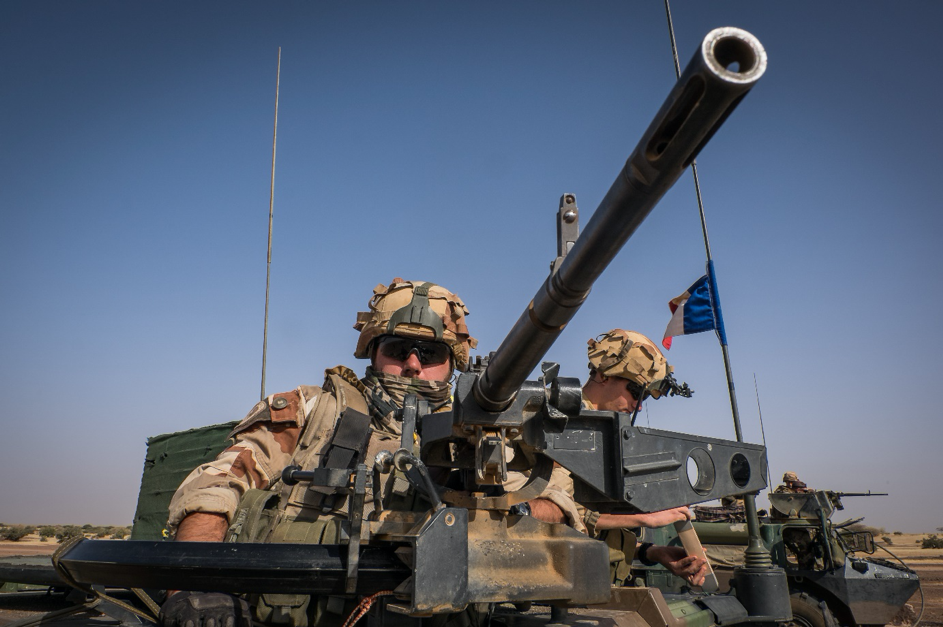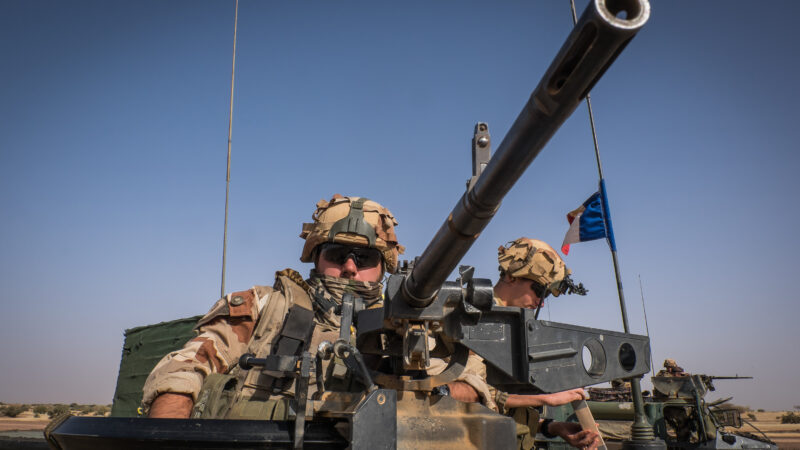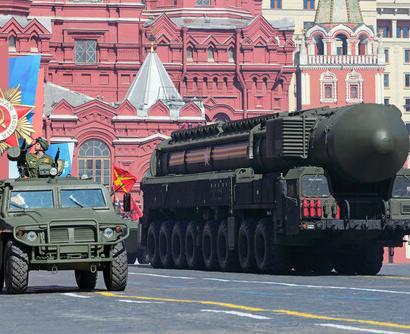Abstract: Since the 2000s, the countries of the Sahel region have been facing a jihadist insurgency. This crisis began with the Algerian civil war, causing Salafist groups to retreat southward. Since then, armed groups have multiplied by gaining the support of local populations leading to the emergence of new movements such as Ansar Dine, MUJWA and the Katibat Macina. In February 2014, five Sahelian states (Chad, Mauritania, Mali, Burkina Faso and Niger) joined forces, closely linking economic development and security. However, despite creating the G5 Sahel, the deployment of the UN mission in Mali (MINUSMA) and the development of the French presence in the region via Operation Barkhane, nothing seems to stem the phenomenon.
Bottom-line-up-front: Today, two terrorist groups compete in the Sahel region: the Support Group for Islam and Muslims (affiliated with al-Qaeda) and the Islamic State in the Greater Sahara. Concerned about this expansion, France agreed to provide military support to states in the region: first in Mali in 2013 with Operation Serval, then throughout the Sahel in 2015 with Operation Barkhane. Today, Operation Barkhane consists of 5,100 men and women and a dozen bases: three permanent support points in N’Djamena (Chad), Niamey (Niger) and Gao (Mali), supplemented by eight bases deployed in the most remote corners of Sahel. However, after eight years of intervention, the jihadist expansion has not been stemmed and is even accelerating. Thus, today, France must reconsider its intervention in the context of the reality on the ground.
Problem statement: How might France adapt its anti-terrorist strategy to face the military-political turmoil in the Sahel?
So what?: On June 10, 2021, the French President announced the end of Operation Barkhane, in progress since 2014 in the Sahel, a region described by Emmanuel Macron as the new “epicenter of international terrorism”. For the French executive, the intervention requires a more significant investment of the G5 Sahel countries and better international cooperation – with a particular call to Europe.

Source: shutterstock.com/Fred Marie
Why is France Intervening in Mali?
“The main reason for the intervention was political, to counter the threat of a terrorist state in Mali. And if it can secure Western companies in neighbouring countries, all the better.”
François Loncle, French socialist deputy.
As a reminder, the French intervention in Mali began with Operation Serval on January 11, 2013, following the Malian authorities request for French support. The objective is threefold.[1] First, to help the Malian armed forces stop the advance of terrorist groups that have taken control of Azawad, the northern part of the country. Second, to help Mali regain its territorial integrity and sovereignty. Furthermore, thirdly, to facilitate international decisions by allowing the quick deployment of two complementary missions: The African-led International Support Mission to Mali (AFISMA) and the European Union Training Mission in Mali (EUTM Mali). With the deployment of 1,700 soldiers, planes and helicopters, France helped Mali to quickly defeat the Islamic groups with the recapture of Gao, Timbuktu, Kidal and Tessalit, in the first month of intervention. In August, Serval was replaced by a more ambitious operation: Operation Barkhane, which spreads over the entire Sahel-Saharan strip, an area as large as Europe.
But why was French intervention necessary in this territory? Mali is a country that has experienced increasing instability since its independence in 1960. Its artificial borders, imposed by colonization, have hindered the process of socio-cultural unification within the country. Indeed, Mali is divided between sub-Saharan groups in the south and predominantly Berber and Touareg populations in the north. This division was reinforced after independence by the economic gap between the two regions, which led the Northern Malians to feel increasingly abandoned by the central government. Indeed, with a drought-stricken climate and a small population, northern Mali is a less developed region. In 1957, the OCRS – a project to establish an administrative alliance of the Sahara regions – was intended to boost the northern Malian economy. However, the Malian government withdrew from the project, exacerbatingtensions with the north. In this context of fracture (that must be placed in a broader context of regional instability), two groups emerged in the north against the central government. On the one hand, the autonomist Tuaregs, represented by the National Movement for the Liberation of Azawad (MNLA), took part in the rebellion in 2012 but were quickly ousted. And on the other hand, the jihadist groups, of which three main groups will conquer northern Mali in 2012: AQIM, Ansar Dine and MUJWA.
Indeed, Mali is divided between sub-Saharan groups in the south and predominantly Berber and Touareg populations in the north. This division was reinforced after independence by the economic gap between the two regions, which led the Northern Malians to feel increasingly abandoned by the central government.
On January 11, 2013, in response to this jihadist expansion, Malian authorities asked France to intervene militarily to support Malian troops. France agreed to help its former colony in order to secure this strategic region.[2] Although French interests are relatively limited in the country – because French companies do not invest its gold – the Malian roads network is the gateway to important French interests: uranium in Niger and economic and port investments in Côte d’Ivoire. In order to protect these interests that go beyond Mali – and to prevent these resources from being appropriated by jihadist groups – Operation Serval, only located in Mali, gave way to Operation Barkhane, covering the entire Sahel region. Despite its strategic importance, Operation Barkhane does not have a good reputation and offers very mixed results.
Why this turning point?
“Barkhane wins battles, does damage in the opposing ranks, but does not win the war.”
Franck Cognard, Journalist at Radio France.
Operation Barkhane at first experienced some successes in its war against terrorism. Hundreds of jihadists, including leaders, have been eliminated. Including, Abdelmalek Droukdal, head of AQIM, in June 2020.[3] On June 13, a military operation on Malian territory, led by the French and Nigerian military, targeted leaders of the Islamic State in the Greater Sahara (IS-GS) in their sanctuary in the Akabar region. According to the French media Libération, a dozen Islamist fighters were killed, and at least four suspected jihadists were taken prisoner[4]. Operation Barkhane has also allowed local armies to receive training from their European counterparts, helping the Malian state to slowly return to areas from which it had been ousted.
However, eight years after the beginning of the French intervention, it is clear that jihadist groups have extended their hold on the Sahel. Insecurity, initially concentrated in the north of Mali, has moved to the centre of the country and then to the south, threatening to surround Bamako, the capital. Neighbouring countries have not been spared either. The Solhan massacre in Burkina Faso on June 4-5 took the lives of 160 people[5]. These victims add up to the many civilians who have perished in the Sahel, bringing the total to more than 2,100 in 2020, a figure that has increased five-fold since 2017 according to the NGO Acled. In addition to jihadist violence, the NGO also denounces an increase in violence by the states themselves on civilian populations and explains that while jihadist groups remain “the main contributors to the violence, community-based militias and government forces often perpetrate equally deadly attacks”[6].
Beyond the increasing difficulty to reach its initial objective, the reputation of the operation, already weak in the Sahel, also withered in France, notably because of recent blunders. An investigation was opened by the UN Mission in Mali (Minusma) after airstrikes in January on the village of Bounty. While France asserted that the two Mirage 2000s targeted “about thirty” jihadists affiliated with al-Qaeda, several villagers assured that only civilians were killed. The MINUSMA investigators “were able to confirm reports that a wedding celebration was hit by the French airstrike” and “that some hundred civilians were present”[7]. In addition, Barkhane is “an operation that costs a lot of money,” said Colonel Michel Goya, a specialist in military risk analysis, who states that “France spends one billion euros in the region each year, all military and civilian expenses combined”. More than a financial cost, the operation must also count its human losses which have increased since the beginning of the year, bringing the total to 55 french soldiers killed (data from June 20, 2021). Thus, according to the Courrier international media, in France, the percentage of opinions in favor of the French intervention has dropped from 73% in 2013 to 49% today.
While France asserted that the two Mirage 2000s targeted “about thirty” jihadists affiliated with al-Qaeda, several villagers assured that only civilians were killed.
Moreover, anti-French sentiment has been growing in Mali in recent months, particularly among the putschists, but more recently with the appointment of the new AQIM leader, who has called for more attacks on the French and the ethnic group’s unity against France. As proof, a car bomb attack against Barkhane vehicles took place on June 21, one day after the first speech of this new leader. With the French presidential elections less than a year away and the rainy season approaching (less conducive to attacks), a change of strategy seemed necessary for the French executive.
Readjusting the Strategy – Cooperation as a Solution?
“The plan changes, not the objective.”
Florence Parly, French Minister of the armed forces, on Twitter.
Reducing the French presence on the ground is not a new objective for the French President. In February 2021, at the N’Djamena summit, Emmanuel Macron already wanted to withdraw 500 soldiers. However, it was necessary to wait for an appropriate window of opportunity. This window appeared with the military coup in Mali. Indeed, the situation has escalated in recent weeks, first with the brutal death of President Idriss Déby in Chad and then with the second coup in eight months in Mali. These circumstances do not reassure France, which does not want to appear as a supporter of the putsch. After ending joint operations with the Malian army on June 3, the French President affirmed his new position: “We cannot secure regions that fall back into anomie because states decide not to take their responsibilities. It is impossible, or else it is a never-ending job”[8].
According to several concordant media sources, while no details have been released so far, the French withdrawal should be planned in three main stages.[9] First, the closure of some military bases in Mali (for conventional forces), then a 30% reduction in the number of troops by the summer of 2022, which should finally reach 50% at the beginning of 2023. This reduction in troops responds to a new strategy, which is divided into three main points. First, there will be more targeted actions using special forces against high-value targets. For Florence Parly, Minister of the Armed Forces: “The jihadists are reorganizing, but the objective is to make this reorganization as difficult as possible. To do this, we must be able to knock the heads of the leaders of these terrorist organizations”[10]. Currently, Iyad Ag Ghaly (head of the Support Group for Islam and Muslims) appears to be Barkhane’s priority target, according to the commander of special operations, General Eric Vidaud. The second point is to move from a frontline force against jihadists to a supporting force for local armies. If the Minister of the Armed Forces defines this assistance as “the fundamental achievement of the last few months”[11], efforts must continue with the deployment of military personnel to several headquarters in Mali or to Sahelian states that wish to receive them. Finally, France wishes to internationalize the fight. This means moving away from the classic external operation (“opex”) of conventional forces towards as much “multilateral cooperation” as possible.
Regarding the third objective, the support to the Malian troops should see a reinforcement of the European presence, assured the French President. For example, the European special forces group Takuba – a 600-man unit (half French) that provides combat support to Malians in the “three borders” zone – should be expanded. Likewise, the European Peace Facility (which should come into effect this summer) will allow financing joint defence operations, military assistance measures, and the supply of lethal equipment. Beyond European support, France also hopes to find reinforcement on the other side of the Atlantic.
Indeed, the announcement of the transition was made during a press conference at the Elysée Palace, in the perspective of a series of international meetings, during the G7 in the United Kingdom from June 11 to 13, and the NATO summit on June 14, in Brussels. By focusing more on the jihadists’ headquarters (targeting missions), Operation Barkhane will have to strengthen its intelligence and develop its cooperation with the United States. According to Matthieu Mabin, Washington correspondent for France24, the US Air Force and US Africa Command already provide 50% of the intelligence used by Operation Barkhane, and this is expected to grow rapidly.[12] Although France expects more investment from its partners and local forces, it has no desire to leave the Sahelian region, as Florence Parly states: “What is important to understand is that France’s military commitment will remain very significant. “[13]
By focusing more on the jihadists’ headquarters (targeting missions), Operation Barkhane will have to strengthen its intelligence and develop its cooperation with the United States.
Clémence Dogniez has worked with the newspaper “Le Taurillon”. She is doing a Master’s degree in the field of International Relations – crisis management. The views contained in this article are the author’s alone.
[1] Ministère de la Défense, “Présentation de l’opération,“ defense.gouv (October 25, 2013), https://www.defense.gouv.fr/operations/missions-realisees/afrique/operation-serval-2013-2014/dossier/presentation-de-l-operation.
[2] Rachel Cooper, “Natural Resources Management Strategies in the Sahel,“ Helpdesk Report (October 2018).
[3] Frank Gardner, “Al-Qaeda chief in north Africa Abdelmalek Droukdel killed – France“, BBCNews, https://www.bbc.com/news/world-africa-52943692.
[4] Célian Macé, “Sahel Au Mali, l’armée française met la main sur des cadres de l’Etat islamique“, Libération, https://www.liberation.fr/international/afrique/au-mali-larmee-francaise-met-la-main-sur-des-cadres-de-letat-islamique-20210616_YDUOSMQDNVDT5BI6R2KACORS5E/.
[5] AMNESTY INTERNATIONAL, BURKINA FASO : IN THE WAKE OF THE SOLHAN MASSACRE, THE PRIORITY MUST BE TO PROTECT THE PEOPLE, https://www.amnesty.org/download/Documents/AFR6042492021ENGLISH.pdf.
[6] Héni Nsaibia, “STATE ATROCITIES IN THE SAHEL : THE IMPETUS FOR COUNTERINSURGENCY RESULTS IS FUELING GOVERNMENT ATTACKS ON CIVILIANS, “ ACLED, https://acleddata.com/2020/05/20/state-atrocities-in-the-sahel-the-impetus-for-counter-insurgency-results-is-fueling-government-attacks-on-civilians/.
[7] UN investigation concludes French military airstrike killed Mali civilians. (2021, 30 mars). UN News. https://news.un.org/en/story/2021/03/1088722.
[8] France suspends joint military operations with Malian forces (2021, 3 juin), France24, https://www.france24.com/en/live-news/20210603-france-suspends-joint-military-operations-with-malian-forces-in-mali.
[9] Elise Vincent, “Risques et périls de la fin de « Barkhane » au Sahel“, Le Monde (June 11, 2021), https://www.lemonde.fr/international/article/2021/06/11/risques-et-perils-de-la-fin-de-barkhane_6083674_3210.html.
[10] Fin de l’opération Barkhane au Sahel : «Nous ne changeons pas d’objectif, il s’agit de continuer la lutte contre le terrorisme», assure Florence Parly (2021, 11 juin), Franceinfo, https://www.francetvinfo.fr/monde/terrorisme-djihadistes/operation-barkhane/video-fin-de-l-operation-barkhane-au-sahel-nous-ne-changeons-pas-d-objectif-il-s-agit-de-continuer-la-lutte-contre-le-terrorisme-assure-florence-parly_4659581.html.
[11] Ibid.
[12] Lutte contre le terrorisme au Sahel : quel avenir pour la coopération franco-américaine? (2021, 11 juin), France24, https://www.france24.com/fr/afrique/20210611-sahel-quel-dispositif-envisagé-pour-remplacer-l-opération-barkhane.
[13] Fin de l’opération Barkhane au Sahel: «Nous ne changeons pas d’objectif, il s’agit de continuer la lutte contre le terrorisme», assure Florence Parly. (2021, 11 juin), Franceinfo, https://www.francetvinfo.fr/monde/terrorisme-djihadistes/operation-barkhane/video-fin-de-l-operation-barkhane-au-sahel-nous-ne-changeons-pas-d-objectif-il-s-agit-de-continuer-la-lutte-contre-le-terrorisme-assure-florence-parly_4659581.html.






